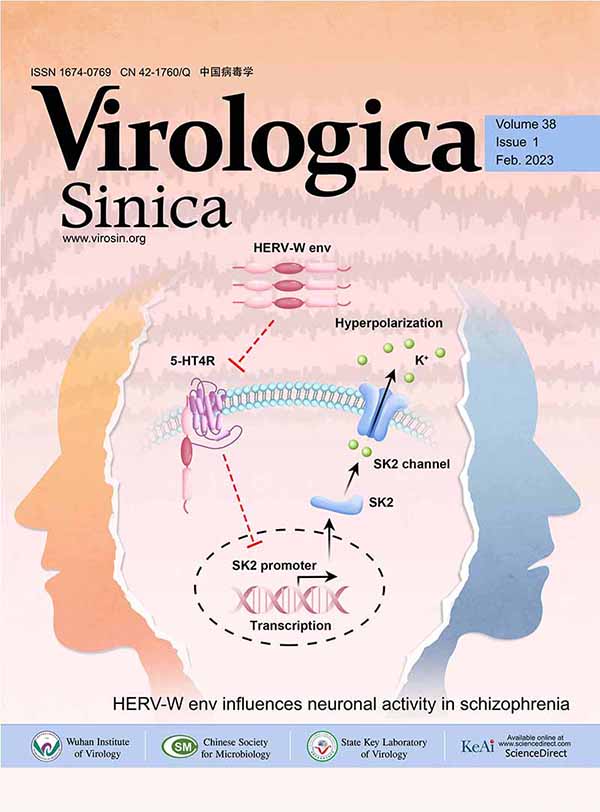JIANG Jia-fu, WU Xiao-ming, ZUO Shu-qing, ZHANG Pan-he, GUO Tian-yu and CAO Wu-chun. Detection of Hantavirus RNA in Different Organs of Natural Infected Rattus norvegicus[J]. Virologica Sinica, 2006, 21(2): 136-141.
Citation:
JIANG Jia-fu, WU Xiao-ming, ZUO Shu-qing, ZHANG Pan-he, GUO Tian-yu, CAO Wu-chun.
Detection of Hantavirus RNA in Different Organs of Natural Infected Rattus norvegicus .VIROLOGICA SINICA, 2006, 21(2)
: 136-141.
-
摘要
为了解野外褐家鼠不同脏器中自然感染汉坦病毒状况和带毒量的差异,选取经检测鼠肺组织中HV-RNA并呈阳性的鼠个体20只,采用巢式RT-PCR检测这些个体心、肝、肺、脾和肾5种共85份脏器中的HV,对阳性标本重复扩增后直接测序,用DNASTAR软件对获得序列进行比较分析。另外,针对汉城型汉坦病毒株Z37- M片段全序列设计定量PCR特异性引物,采用SYBR Green实时定量PCR法,检测上述85份不同脏器中HV带毒量情况与相对差异。结果显示:RT-PCR对除肺脏之外的其它脏器中HV-RNA的检出率较低(11/65),不同个体肺组织来源的HV-M 片段变异较多,其中A→G碱基变异类型占1/3强。从11份除肺之外的脏器中扩增到的HV-M基因序列和其对应同一褐家鼠个体肺脏HV-M片段相比,其碱基差异不大;一肺脏来源的与该个体其他脏器来源的HV-M片段两个位点存在A→G差异,并分别导致两位置氨基酸差异。定量检测结果显示:褐家鼠不同脏器中HV-RNA检出率差异有统计学意义(χ2=16.10, P=0.003),总体阳性率大小为肺肝肾心脾;肺脏中病毒的分布比其他脏器更为普遍。带毒量也以肺脏中最高,其它脏器之间HV带毒量没有显著性差异(χ2=8.79, P=0.088)。这些结果说明:褐家鼠肺脏是HV侵犯与贮存的主要靶器官,HV基因在该器官中可能更易发生变异。这对进一步了解HV在宿主体内的贮存规律、传播及其在流行病学上的意义将有所裨益。
Detection of Hantavirus RNA in Different Organs of Natural Infected Rattus norvegicus
-
1.
State Key Laboratory of Pathogen and Biosecurity, Beijing Institute of Microbiology and Epidemiology, Academy of Military Medical Science, Beijing, 100071, China
-
Corresponding author:
CAO Wu-chun,
-
-
Abstract
In order to understand the genetic diversity and distribution of Hantavirus (HV) in different tissues of wild brown rats, we amplified the partial M segment of HV from various organs of 20 hantavirus positive Rattus norvegicus individuals which were collected from Beijing. Then the amplicons were sequenced directly and the genetic variation analysis was made with DNASTAR software. The “A→G” transitional mutations were detected only in the infected lung tissue. We also evaluated the HV quantities in these organs with real time PCR. Significant difference of HV prevalence rates was found among different organs of R. norvegicus (χ2=16.10,P=0.003). The virus-loads in lung tissues of natural infected rats were significantly higher than those in other studied tissues. These results suggested that lung tissue of natural infected rat serves as the main target site for HV maintenance and replication; and HV mutation was more prone to occur in lungs. The findings are useful for further research in HV epidemiology and reservoir–HV relationship.
-

-
References
-
Proportional views

-
-














 DownLoad:
DownLoad: